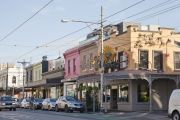
Why owner-occupiers beat investors for industrial property
Owner-occupier buyers wanting a smaller industrial asset will have an edge over investors for at least another 12 months, valuer Opteon says, as they are not dependent on rental returns that don’t keep up with loan servicing costs.
Business owners needing space to support the country’s growth in e-commerce were a key driver of last year’s 16 per cent increase in industrial asset values in the sub-$40 million market, Opteon said.

They had an advantage over investors for whom rents were not keeping up with rising loan servicing costs.
“Owner-occupiers can pay more because the price they can pay is based on the fundamentals of their business rather than the investment metrics of property,” Opteon general manager Ross Turner said.
“The investment metrics for longer-term investors might be holding back the investment option.”
Commercial real estate assets across the industrial, retail and office sectors in the sub-$40 million range will pick up in the medium term as interest rates stabilise and then fall, easing debt servicing costs and giving buyers more money to spend on them, according to Opteon’s Annual Data Review 2024.
But until investors were able to raise rents more in line with market changes, rather than at fixed intervals, owner-occupiers in the industrial space targeted by small investors, syndicates and high-net-worth individuals will enjoy an advantage over investors, Mr Turner said.
“Those two things will probably take anything from 12 months to a few years,” he told The Australian Financial Review.
The increase in borrowing costs from May 2022 when the Reserve Bank of Australia started lifting interest rates from their record low levels created a clear gap between what owner-occupiers and investors were willing to pay.
A vacant-possession industrial property at 1/64 Burrows Road in southern Sydney’s Alexandria sold in October 2022 for $10.3 million – or $9254 a square metre, on a market net yield of 2.61 per cent – to an owner-occupier, Opteon records show.
That same month, a smaller adjacent property at 2/64 Burrows Road with an existing five-year lease to 2024 and extension options until 2029 sold for $6.7 million – or $7554 a square metre, on a market net yield of 3.46 per cent – to an investor.
There were already signs the spread, or gap, was narrowing, Mr Turner said.
“As the cycle continues, the difference between the two is beginning to normalise,” he said.
A cloud of uncertainty still hung over office assets, as despite return-to-office mandates by employers driving some workers back, overall office demand was still uncertain in a time of hybrid working practices, he said.
Average office values increased 7.1 per cent from December 2020 to March 2023, but a 5.5 per cent overall decline in calendar year 2023 – mainly reflecting weakness in the NSW and Victorian markets – left the average price in the sub-$40 million office market at $7396 per square metre, up just 1.7 per cent from three years earlier, according to the Opteon report based on data by consultancy Real Investment Analytics.
“Office has been more impacted across the country in terms of yield softening and in occupancy,” Mr Turner said. “It’s not necessarily news but that’s going to continue to happen.“
Some buyers are already taking advantage of counter-cyclical conditions.
Brisbane-based fund manager Exceed Capital has bought three office buildings in three years from ASX-listed real estate investment trusts, most recently a three-storey building in inner-city Brisbane’s Toowong for $37 million from Centuria REIT last month.
”We know the market will come back in years to come and that we can add value to resell at a higher price,” Exceed’s Vaughan Hayne said.
Retail property values will also improve as interest rates fall, but they continue to suffer the headwinds of retail sales that rose just 0.1 per cent in April, defying expectations of a 0.2 per cent increase.
Healthcare-aligned retail assets – such as doctors’ suites and dentistry clinics – that benefited from non-discretionary spend were doing better than high street retail linked to offices, such as drycleaners and coffee shops, Mr Turner said.
Perth retail vacancies were higher than other cities as its rate, which was already above the national average, faced extra drag in office-aligned retail from increasing hybrid working practices, he said.











